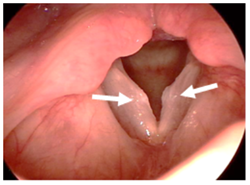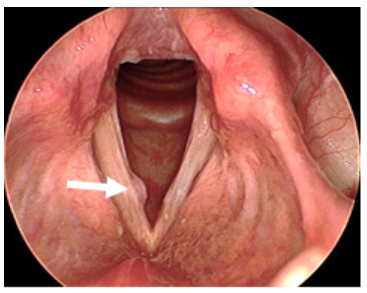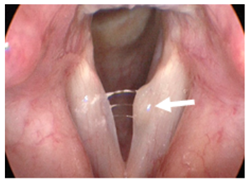Nodules, polyps, and cysts are all examples of non-cancerous (benign) vocal fold growths that affect the way the vocal folds vibrate.
Vocal fold nodules are one of the most common benign vocal fold growths. They generally form on both vocal folds in an area that absorbs the highest level of impact stress during voicing. Nodules can impair vocal fold vibration and cause vocal difficulties. In some cases, nodules can firm up into callus-like growths if left untreated.
Vocal fold polyps can present in a number of forms and affect voice differently depending on the size and location of the mass. These are generally softer growths that form on one or both vocal folds. They may have a blister-like appearance or appear as a denser growth on a small stalk.
Vocal fold cysts are a rarer benign growths situated deep in the surface of the vocal fold. They can form due to plugging of a mucous-secreting gland beneath the surface of the vocal fold.
|
Vocal fold nodules. |
Right vocal fold polyp. |
Left vocal fold cyst. |
Causes of Benign Vocal Fold Lesions
In most cases, vocal fold nodules and polyps are attributed to voice misuse and abuse such as high levels of voice use, sub-optimal speaking environment (continuously talking over loud background noise), or poor vocal health/hygiene. People with heavy professional or occupational voice demands like teachers, clergy, call center workers, salespeople, lawyers, physicians, etc. are at greater risk for developing benign vocal fold lesions.Symptoms of Benign Vocal Fold Lesions
Common symptoms may include hoarseness, breathy voice quality, vocal strain or fatigue, change of pitch, voice breaks, and general variability of voice quality.Diagnosis of Benign Vocal Fold Lesions
Our voice care team at the Voice and Swallowing Center has the advanced training and skills necessary to diagnose this voice condition. During the initial visit, you will be assessed by one of our laryngologists and likely, an additional session with one of our voice pathologists. We use cutting-edge diagnostic tests to determine the cause of your voice disorder and to develop your plan of care. Following a thorough discussion of your symptoms and medical history, be expected to undergo the following assessments:
- Video Laryngostroboscopy: Using a small camera inserted through the nose or mouth, our specialists are able to assess the health and function of your larynx (voice box), and determine the presence of any vocal fold growths or abnormalities. Click the link to learn more.
- Perceptual, Acoustic, and Aerodynamic Voice Evaluation: This is a comprehensive assessment of multiple voice parameters completed by the voice pathologist.
Non-Surgical Treatment
You may be evaluated by one of our voice pathologists to determine your candidacy for voice therapy. In some cases of benign vocal fold growths (particularly vocal fold nodules and small vocal fold polyps), voice therapy with special attention to efficient and healthy voice use may resolve or significantly reduce voice symptoms. In other cases, voice therapy may need to be combined with surgical treatment (i.e. before surgery, after surgery, or both). Medications may also be used to treat other problems that may be contributing to the voice disorder (ie allergies, acid reflux).



